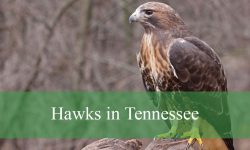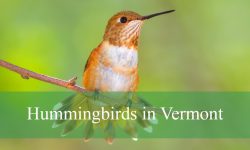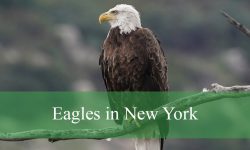Birds with crowns epitomize nature’s flair for the dramatic, blending elegance with the wildness of the natural world.
These birds, from the intricate crest of a peacock to the subtle tuft of a kingfisher, showcase a mesmerizing array of headgear that fascinates and delights observers.
Their crowns, more than just decorative, often play vital roles in communication, mating, and camouflage.
Different Types of Birds with Crowns
Gray-Crowned Crane
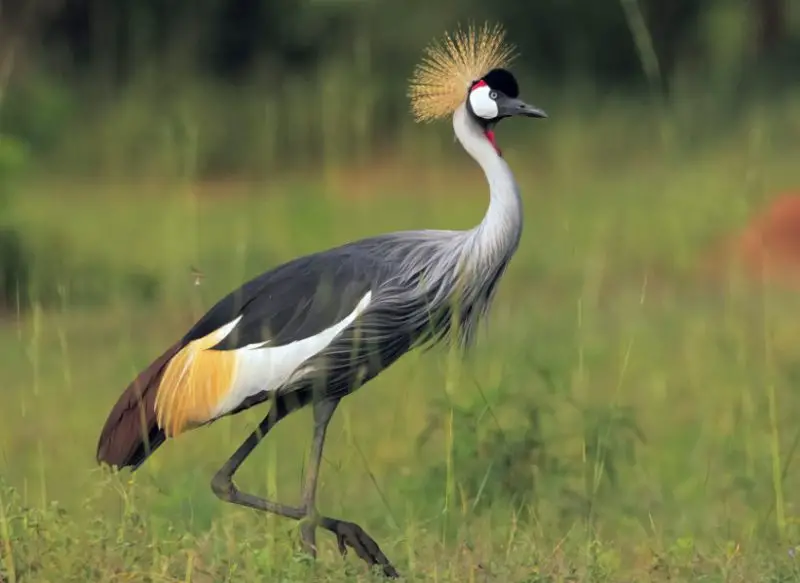
The Gray-Crowned Crane, scientifically known as Balearica regulorum, stands out with its blue-gray plumage, distinctive black and white face, and a striking crown adorned with golden-yellow plumes. Immatures boast a rustier hue.
These elegant cranes are often spotted solo, in pairs, or in flocks across various habitats, including wetlands, flooded grasslands, and around artificial bodies of water. During foraging or adverse weather conditions, they may venture into other open habitats.
As omnivores, their diet comprises plants, grains, insects, snakes, and small fish, showcasing their adaptability and varied culinary preferences.
Black-Crowned Crane
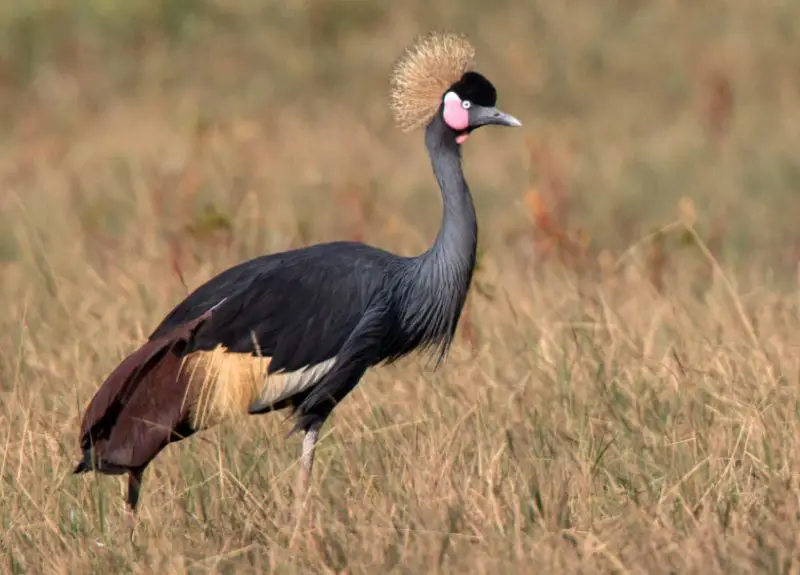
The Black-Crowned Crane, scientifically named Balearica pavonina, boasts black plumage with distinctive pale pink and white cheek patches, contrasting against pale wing panels and a striking yellow crown reminiscent of hay.
In flight, its white wing panels become more prominent.
Often seen in wetland habitats and dry fields of Central Africa, these cranes typically move in pairs or large flocks.
Resembling the Gray-Crowned Crane, they share an omnivorous diet, feasting on grasses, seeds, grains, crustaceans, small mammals, and reptiles.
Eurasian Hoopoe

The Eurasian Hoopoe, scientifically known as Upupa epops, flaunts its vibrant orange plumage adorned with zebra-striped wings, a distinctive long-curved bill, and an eye-catching orange and black crown reminiscent of a Chinese fan.
These features make it challenging for the bird to camouflage. While its flight pattern and rounded wings may resemble those of a hummingbird, its elongated and robust bill sets it apart.
Preferring semi-open habitats like heathlands, farmlands, orchards, and grassy lawns, the Eurasian Hoopoe forages on the ground, utilizing its long bill to unearth insects, small reptiles, and frogs. Though they are mainly carnivorous, they occasionally indulge in seeds and berries.
Royal Flycatcher

The Royal Flycatcher, scientifically named Onychorhynchus coronatus, is a seldom-spotted medium-sized brown flycatcher boasting a long bill and pale cinnamon-colored rump and tail.
Its most remarkable feature is its crown, rarely displayed but intricately patterned. When revealed, the crown takes on a stunning hammerhead shape in bright red and violet-blue hues, resembling a fan.
Inhabiting humid tropical forests of Central and Northern South America, they flit around the mid-level canopy, hunting insects like ticks, leafhoppers, cicadas, butterflies, dragonflies, and grasshoppers, showcasing their vital role in the forest ecosystem.
Victoria-Crowned Pigeon
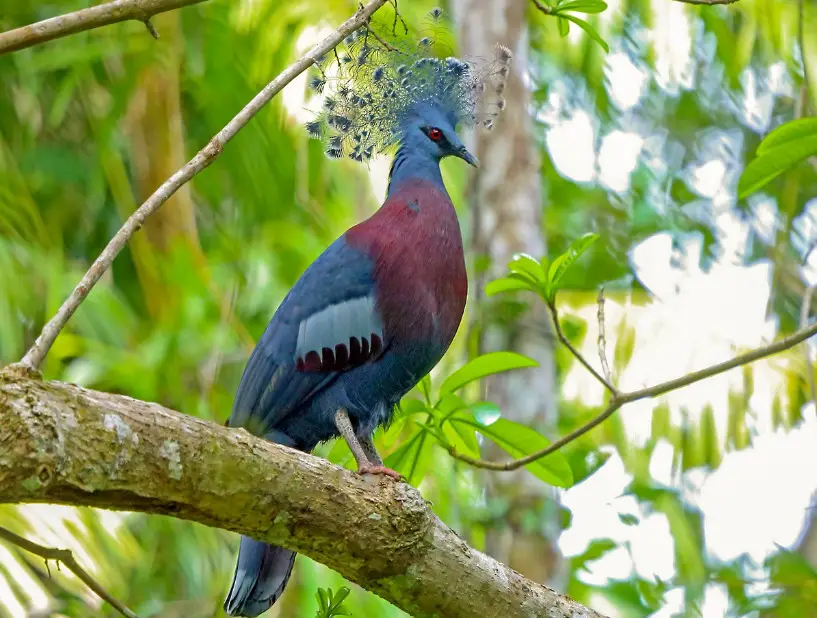
The huge Victoria-Crowned Pigeon, scientifically known as Goura victoria, is identified by its magnificent blue-white-tipped crown, maroon chest, and blue-gray plumage. It is distinguished from other crowned pigeon species by its distinctive wing patches, which are pale gray with maroon points.
Primarily found in Papua New Guinea’s lowland swamp woods, it forages for fallen fruit on the forest floor.
It feeds mostly on the ground, mostly on fruit, seeds, grains, and small invertebrates, however it seems to like figs the best.
Pink Cockatoo
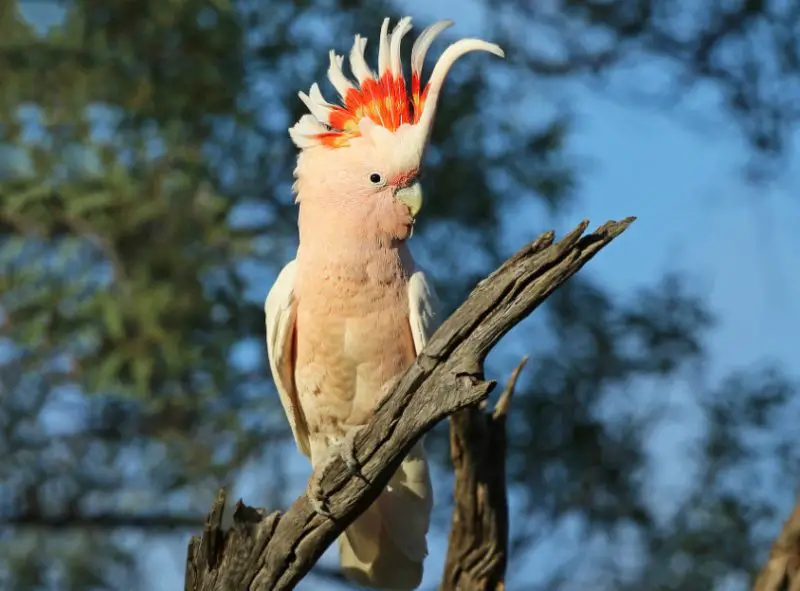
The scientific name for the unique bird, Lophochroa leadbeateri, is the Pink Cockatoo. It has white upperparts, pink underparts, and a long, graceful white crown with a red and yellow base.
Its pink underwings are clearly apparent while it is in flight.
Throughout Australia, it can be found in semi-arid, arid, and dry forest areas. It is regarded as an iconic species of the outback.
Eating seeds, fruits, nuts, tubers, roots, and insect larvae, the Pink Cockatoo demonstrates its versatility in foraging by searching both the ground and tree branches for food.
Great Blue Turaco
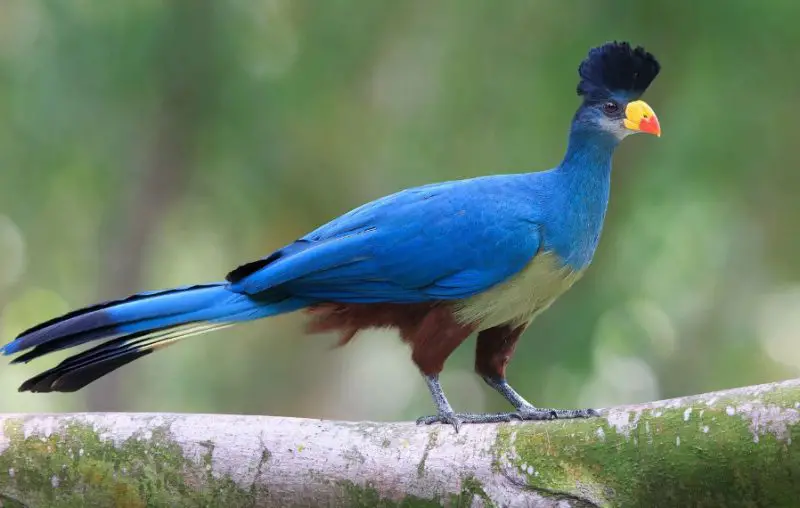
The Great Blue Turaco (Corythaeola cristata), a bird as majestic as its name suggests, thrives in the lush landscapes of Western Africa, Uganda, and Rwanda.
Sporting a striking red-and-yellow bill and adorned with a mix of turquoise, black, and yellow feathers, it’s a spectacle of nature. Its unique appearance is highlighted by a tall, blue-black crown and intricate tail feathers, marked by a distinctive black bar.
This bird, reaching lengths of up to 76 cm, is not just admired for its beauty but also sought after for its meat and feathers.
Found in small groups, these birds prefer the seclusion of rainforests, gallery forests, or savannas dotted with forest patches.
With a diet that spans from fruits to insects, they ingeniously forage in the cooler evenings, dodging the day’s heat.
Sulphur-Crested Cockatoo
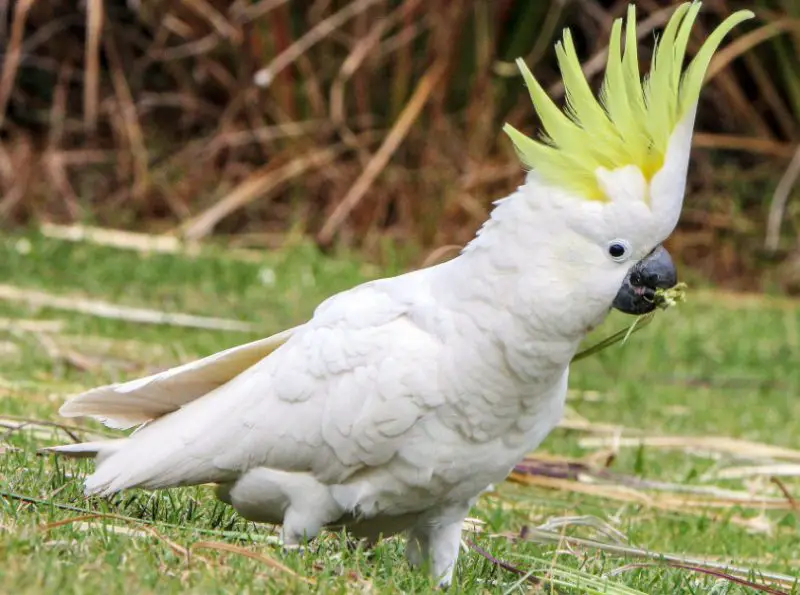
The Sulfur-crested Cockatoo (Cacatua galerita), a striking bird native to Australia and Papua New Guinea, dazzles with its large white body and contrasting dark bill.
It’s renowned for its broad wings and the eye-catching yellow crown, which it proudly displays upon landing. This bird has a unique flight pattern, characterized by short glides punctuated by regular flaps, occasionally skipping a beat.
Despite its popularity as a pet, it’s also considered a pest in some Australian regions due to its rapid population growth.
These cockatoos adapt well to diverse habitats, including urban areas, thriving in woodlands, parks, and gardens.
Their diet is primarily herbivorous, feeding on seeds, grasses, grains, berries, nuts, and roots, foraging both on the ground and in trees.
Crested Partridge
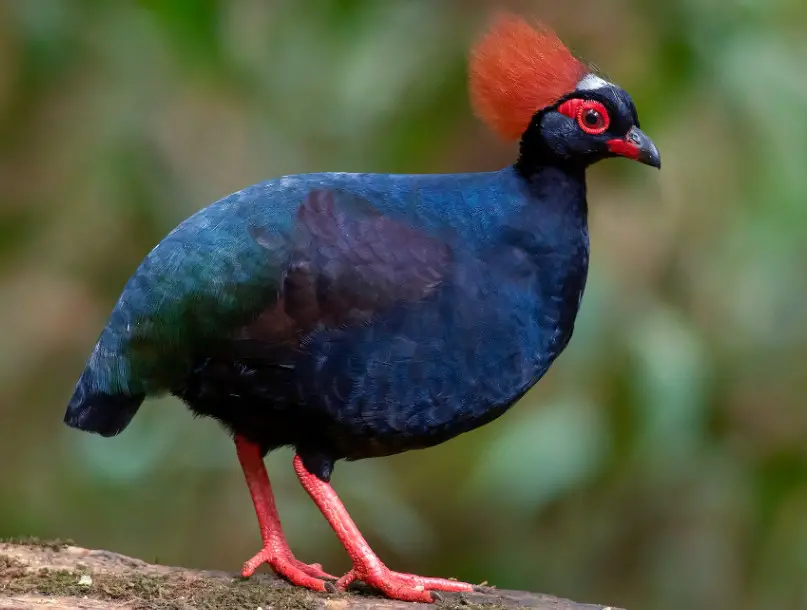
The Crested Partridge (Rollulus rouloul), identifiable by its small, plump form and short tail, thrives in the wet forests of Malaysia, Singapore, and Indonesia.
Distinguishing features include the males’ dark green, almost iridescent body and distinctive fluffy red crown, resembling a pompom, while females display a moss-green plumage without the crown.
Both sexes are marked by a bright red eye ring, making them stand out in their elusive habitat.
Often hidden, they quietly forage on forest floors, their diet comprising seeds, fruits, insects, and occasionally small mollusks, blending seamlessly into the dense green undergrowth.
Kagu
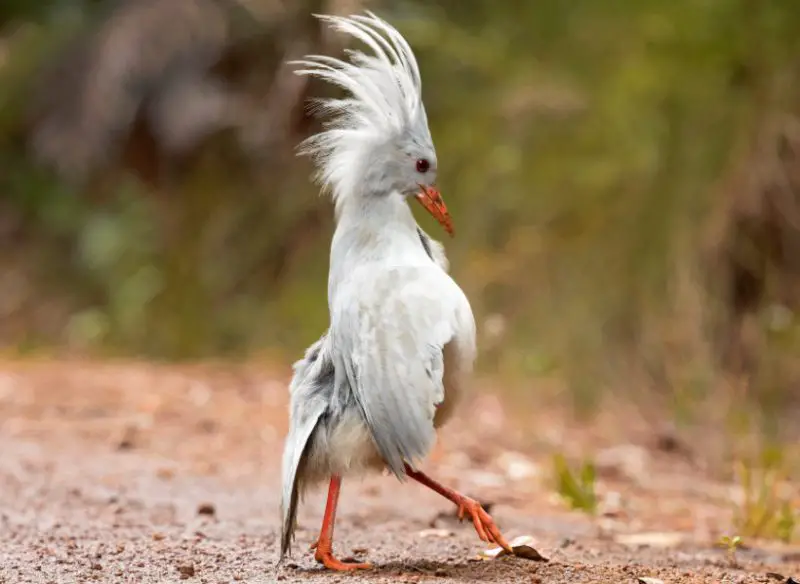
The Kagu (Rhynochetos jubatus), a unique bird endemic to New Caledonia, stands out with its small size, bluish-grey plumage, and distinctive long crown adorned with nasal corns, earning it the local moniker “the ghost of the forest.”
Thriving in both rainforests and drier woodlands, it’s known as a habitat generalist, adapting well to various environments across the island.
Feeding mainly on insects like larvae, spiders, centipedes, and a variety of other invertebrates, the Kagu employs its long bill skillfully to forage in leaf litter and among rocks, demonstrating its resourcefulness in hunting prey.
Black-Crowned Night Heron
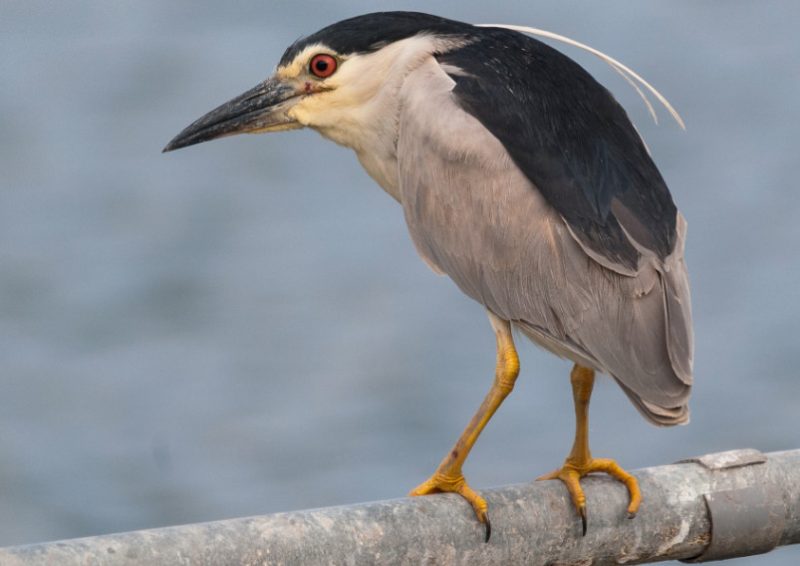
A robust and cosmopolitan species, the Black-Crowned Night Heron (Nycticorax nycticorax) is found in North America, Central America, South America, Europe, South Asia, Southern Asia, and occasionally in Africa. It is easily recognized by its sturdy build, pale grayish feathers, and distinctive black crown. Its mysterious look is enhanced by its ruby eyes.
Heron chicks have brown feathers with yellow eyes. These versatile carnivores thrive in a variety of wetland habitats, including marshes, rivers, ponds, and mangrove forests. They opportunistically hunt for fish, frogs, tadpoles, snakes, and turtles.
Golden-Crowned Kinglet

Small and gregarious, the Golden-Crowned Kinglet (Regulus satrapa) is a songbird found in Mexico and North America. recognizable by its unique wing pattern, black head stripes, and a tiny yellow stripe on top of its head that, in disturbed animals, especially males, changes into a bright orange crown. The female has a less colorful crown.
Mostly found in coniferous woods, these birds dart among the highest branches of fir trees. They prefer to breed in montane or boreal forests, especially in trees that are spruce or fir.
Their main food source is insects, specifically gnats, aphids, caterpillars, and tiny beetles. They are frequently seen floating in the air and flapping their wings as they forage.
Orange-Crowned Warbler
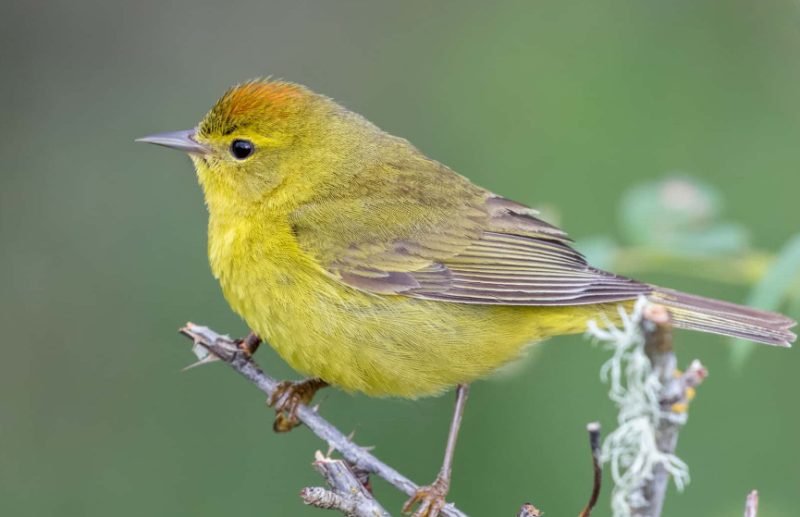
Found in Mexico and North America, the Orange-Crowned Warbler (Leiothlypis celata) is a small bird with olive plumage. Depending on the population, its plumage can range from gray to bright yellow, with pale eye arcs and a short dark line through the eye. Males get their name from the pale yellow coloring on their faces and crowns that increases into a vivid orange hue during breeding season.
They adapt well to a variety of habitats, however they favor places with dense, low vegetation, forest edges, and scrubby areas.
They eat different things in different seasons. In the summer, they mostly eat insects and larvae; in the winter, they eat berries, honey, and tree sap.
Ruby-Crowned Kinglet

Similar in size to the golden-crowned kinglet, the ruby-crowned kinglet (Corthylio calendula) is a small, gregarious songbird. Its ruby crown, which is unique to males only and is usually hidden but exposed when disturbed, is what makes it easily identifiable despite having plain olive plumage, an irregular white eye ring, and greenish wing and tail feather margins.
This plant is found in a variety of environments, such as field borders, shrubby woodland, and deciduous and coniferous woods.
Primarily consuming insects like tiny beetles, flies, leafhoppers, and caterpillars, they also occasionally eat spiders and their eggs. The Ruby-Crowned Kinglet is a pleasant sight in Mexico and North America due to its bright crown and active foraging habits.
White-Crowned Sparrow
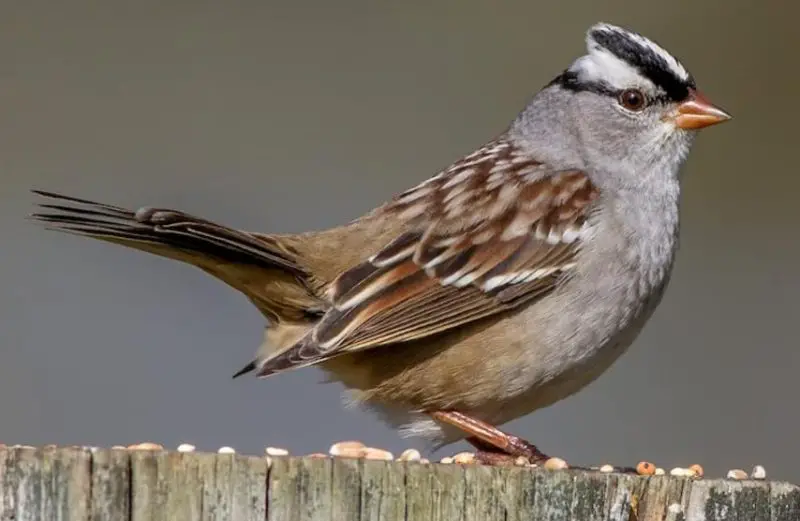
Zonotrichia leucophrys, often known as the White-Crowned Sparrow, is found in northern Mexico and North America. It is a huge, recognizable sparrow with gray underparts, a long tail, and a bill that can be pink or yellow in hue. The plumage of juveniles is a more subdued shade of brown and tan. Their distinctive black-and-white crown pattern is what makes them stand out the most.
The majority of these sparrows’ habitats are open or shrubby areas like the tundra, high alpine meadows, and the borders of forests. They are found in thickets, weedy fields, agricultural areas, roadsides, and backyards throughout their journey, and they frequently visit feeders.
White-Crowned Sparrows are omnivores that eat seeds, insects, grains, and fruits. They do well in places where there are patches of grass or bare earth.
Blue Jay
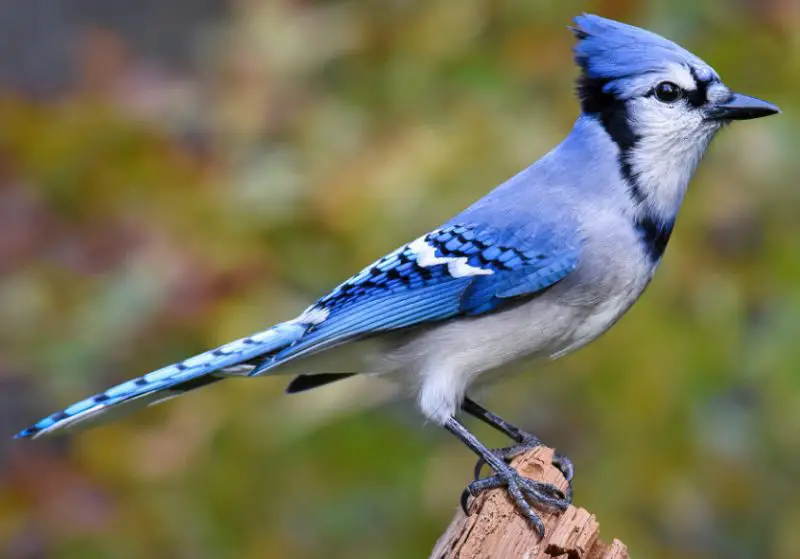
The distinctive blue crest of the blue jay (Cyanocitta cristata), which may be raised or lowered based on activity, is one of the birds’ most recognizable features in North America. Their scientific term, ‘crestata’, which means ‘crested’, reflects the significance of the crest. Usually, their crests lie flat when they feed.
The Toronto Blue Jays, for example, have a crested Blue Jay head on their emblem. Beyond biology, Blue Jay crests have cultural meaning that influences norms such as sports team designs. These birds are even more attractive due to their vivid appearance, which contrasts their blue and white plumage.
They are mostly found in the Eastern United States and Canada, where their characteristic blue crests are visible.
Cedar Waxwing
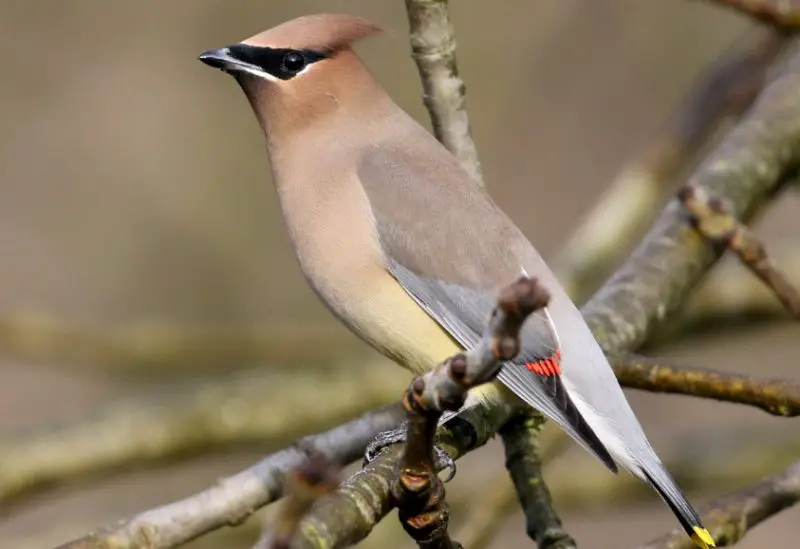
The native North American species known as the Cedar Waxwing (Bombycilla cedrorum) is frequently found in cedar woodlands, where it mostly feeds on cedar cones but also eats other foods. It has a noticeable crest and brown and gray feathers with red wax-like markings on its wings.
Its broad black and white stripe that runs from the black beak to the sides of the head contrasts with its long, brilliant brown crest. Wintering grounds for this migratory species are mainly the Southern United States, Central America, and portions of the Caribbean.
Canada, the US, Mexico, Belize, Nicaragua, Costa Rica, Panama, and Cuba are among the countries where it is distributed.
Belted Kingfisher

The Belted Kingfisher, or Megaceryle alcyon, is distinguished by its slate blue plumage and prominently displayed huge crest. Crowns are present on both sexes, but the female’s plumage is more colorful, which is uncommon in birds since the males usually have brighter plumage.
This species’ head and crest have subtle gray undertones against a striking slate blue color. The slate blue tone of its wings is accentuated by a neckband and a white underside.
With a range that includes Alaska, Canada, the United States, Mexico, Guatemala, Costa Rica, Panama, Cuba, and Ecuador, the Belted Kingfisher is a common sight in landscapes across North and Central America.
Tufted Titmouse
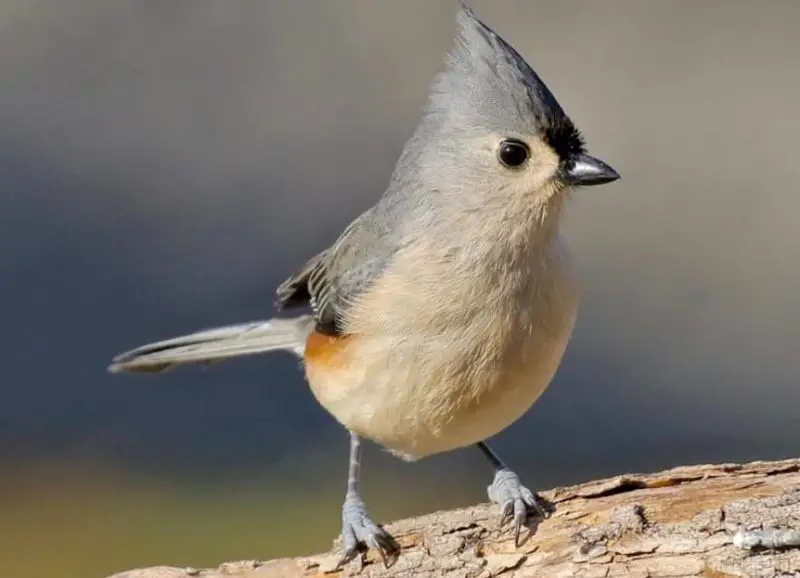
The unique tiny gray crest of the Tufted Titmouse (Baeolophus bicolor) birds is unique to the United States. Their use of tree holes for nesting, together with their tufted characteristic, distinguishes them.
Their back, wings, and dark gray beak are all shades of gray, and this particular silver-gray color is reflected in their crest. In addition to its white and brown-red underbelly plumage, the crested bird has a black patch between its eyes for contrast.
These birds are notable for having particular shades of gray on their legs. Fruits and insects found on the ground and in trees make up their diet.
The Eastern United States is where the Tufted Titmouse is mostly found.
Pileated Woodpecker
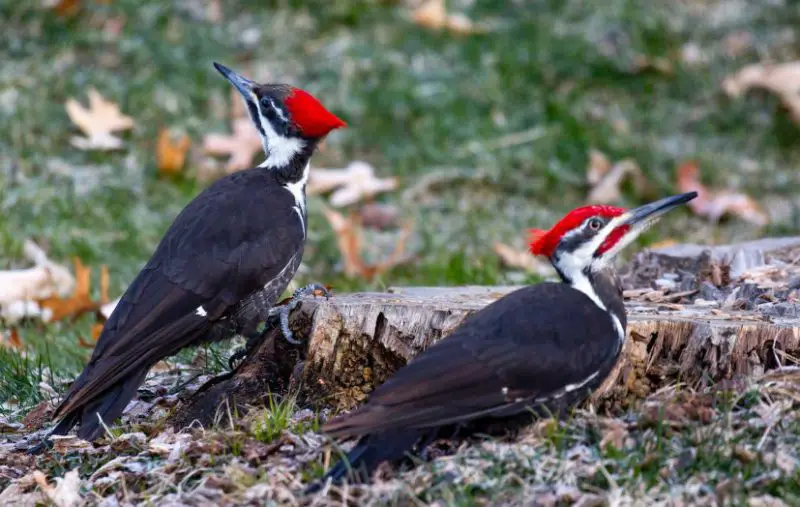
Famous for its eye-catching red head and crest, the Pileated Woodpecker (Dryocopus pileatus) is a famous crested species native to North America. Its bright red head is further emphasized by the black and white wings and belly.
The woodpecker’s name, which comes from a Latin phrase that means “capped,” was inspired by its distinctive crest. With populations spanning both Eastern and Western regions, this species is widely distributed in both Canada and the United States.
They live mostly in the warmer southern parts of Canada. The Pileated Woodpecker is a notable bird species in North America because of its characteristic red crest.
Steller’s Jay
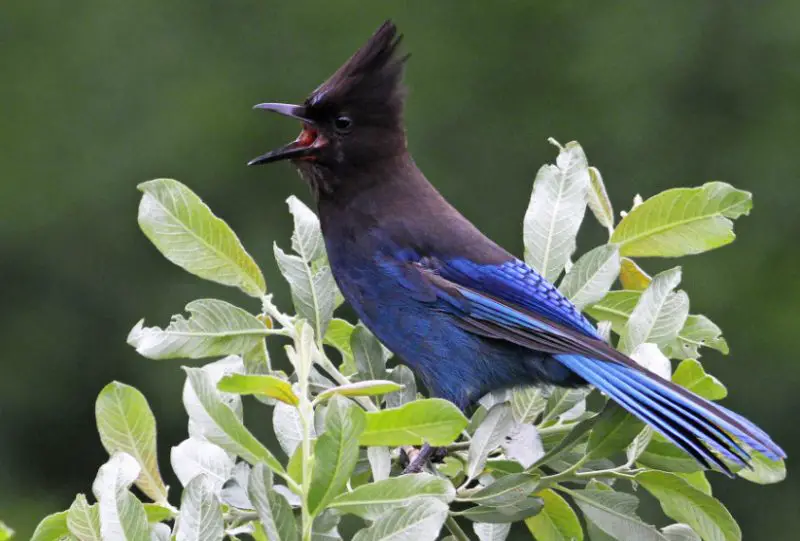
With more than ten subspecies, the Steller’s Jay (Cyanocitta stelleri) is a common crested bird in North America. It is distinguished by a tall crest with blue frontal stripes that is usually black but can also occasionally be blue.
It’s interesting to note that the appearance of the crest varies by location; inhabitants in the northern US and Canada tend to have taller crests.
From California to Alaska, these jays live in a variety of environments west of the Rocky Mountains, such as mixed, pine, and oak forests.
Their significance in the region’s bird diversity is further enhanced by their extensive range throughout Western North America, which makes them a common sight in a variety of ecosystems.
Black-Crested Titmouse
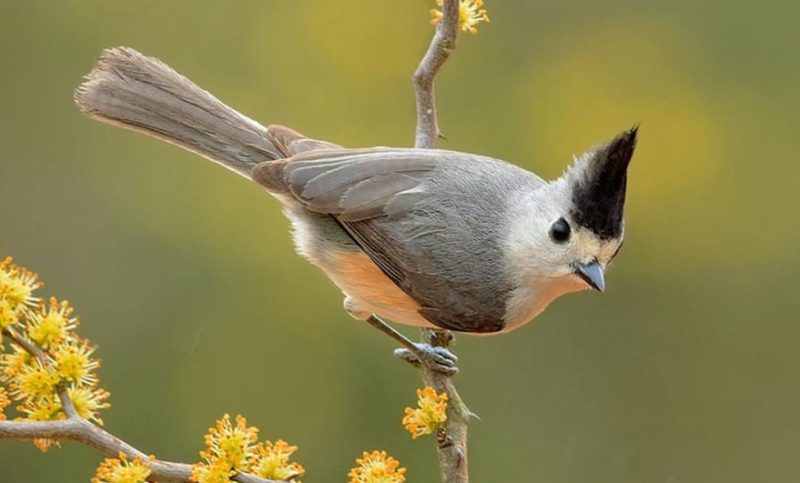
The stunning long black crests of Black-Crested Titmouse birds (Baeolophus atricristatus), which are native to the Southern United States, give them their name.
The name of the species comes from the fact that females have gray crests while males have black ones.
Titmice males have erect black crests that contrast with their light gray body and almost white underside.
Females have darker-colored wings and gray plumage on their head, crest, and underbelly.
Black-Crested Titmouses can be found in a variety of tree environments and are easily identified by their characteristic nature song.
These titmice, which may be found in Mexico and South Texas, are beloved for their unique looks and melodic sounds.
Red-Crested Cardinal
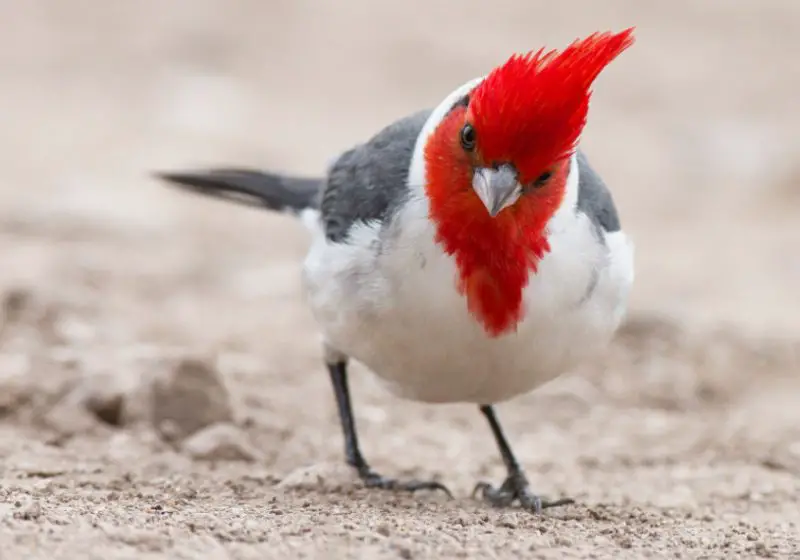
One of the most prevalent crested species with a multicolored look, the Red-Crested Cardinal (Paroaria coronata) gets its name from its vivid red crest.
The head and crest are both bright red in color, reaching the neck, but the body and underside are mostly white.
This cardinal species’ distinctive gray and black wings add to its uniqueness.
Although both sexes have a red crest, the color of the female’s is a duller brown-red.
Red-Crested Cardinals are native to South America and are found mostly in Bolivia, Paraguay, Uruguay, and Argentina. They provide color to their natural environments.
Sandwich Tern
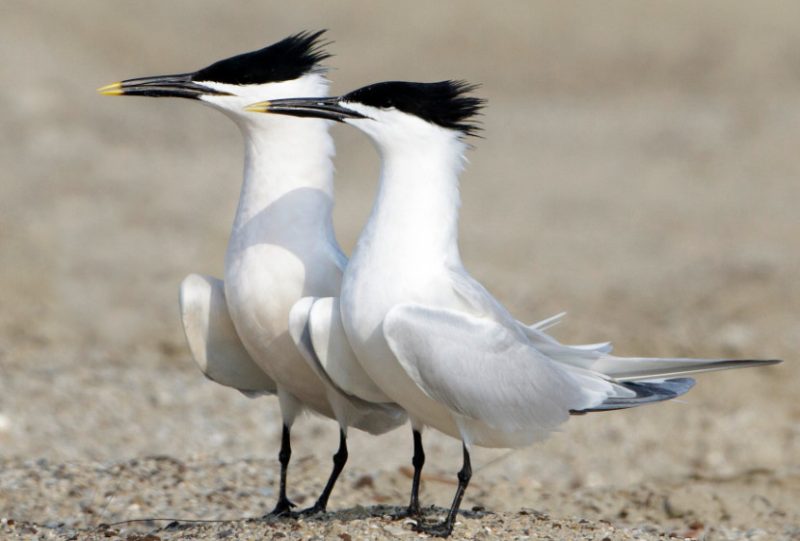
During the breeding season, Sandwich Terns (Thalasseus sandvicensis) have a characteristic black crest; in the winter, they have a white crest and crown. Their wings, which are primarily white, seem almost white and pale gray.
The bird’s black and white look is contrasted with a yellow beak, which is limited to the crest and head.
Sandwich Terns lay predominantly off-white eggs with black specks throughout their life.
These terns range widely in size, usually not going over 17 inches, and are well known for their daring dives to capture fish, which accounts for their abundance in coastal regions throughout the Americas, Europe, Africa, and the Middle East.
Sandwich terns, which can number up to 500,000 worldwide, are representative of the world’s coastal habitats.
Elegant Tern
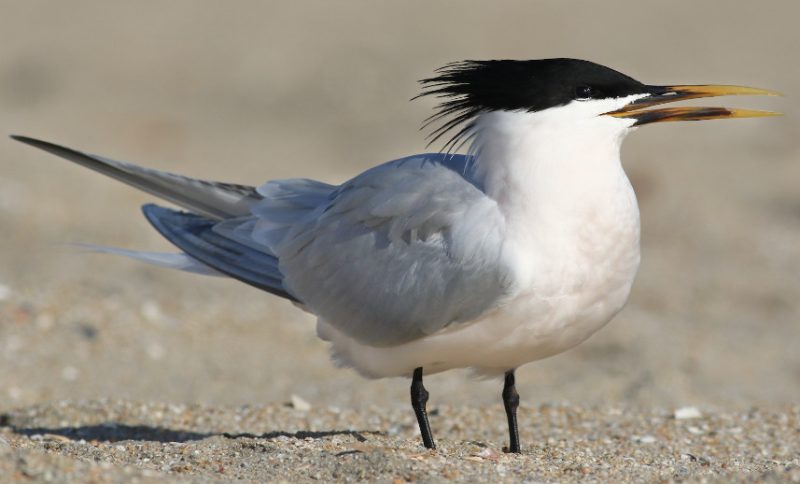
The striking black, white, and gray plumage of the Elegant Tern (Thalasseus elegans) is one of its distinguishing features.
A striking black crown and facial patterns surrounding the eyes and beak are connected by a conspicuous black crest.
Its head, neck, and back are covered with white feathers, while its wings are a light gray tint.
The Elegant Tern is a diving-adapted bird that mostly eats ocean fish.
It nests on beaches and is limited to coastal habitats on the US West Coast, Western Central American Coast, and Western South American Coast.
Although primarily stationary, the species’ unusual migratory tendency has been highlighted by sporadic sightings recorded outside of the Americas.
Pyrrhuloxia
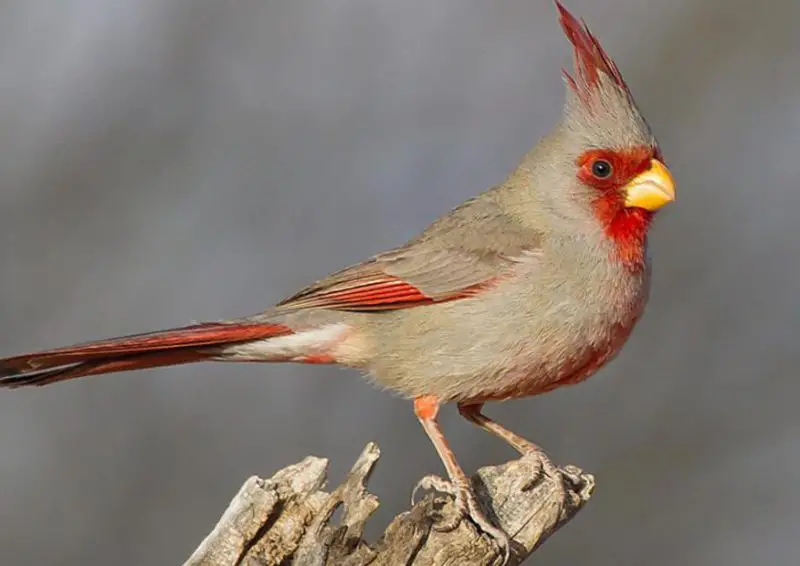
Male and female Pyrrhuloxias (Cardinalis sinuatus) have characteristic crests that range in hue from red to gray.
Males are colorful during breeding season, with accents of red on the tail, wing edges, and crest against a body that is a bright gray color.
Less colorful, females usually have a gray body and crest.
Males display bright crimson tones on their underside and crest in March.
Pyrrhuloxias are found in South Arizona, South New Mexico, South Texas, Baja California, and Mexico. They are native to warm Southern US climes.
In their natural environments, their bright plumage and distinctive crests make them a beloved sight.
Red-Whiskered Bulbul
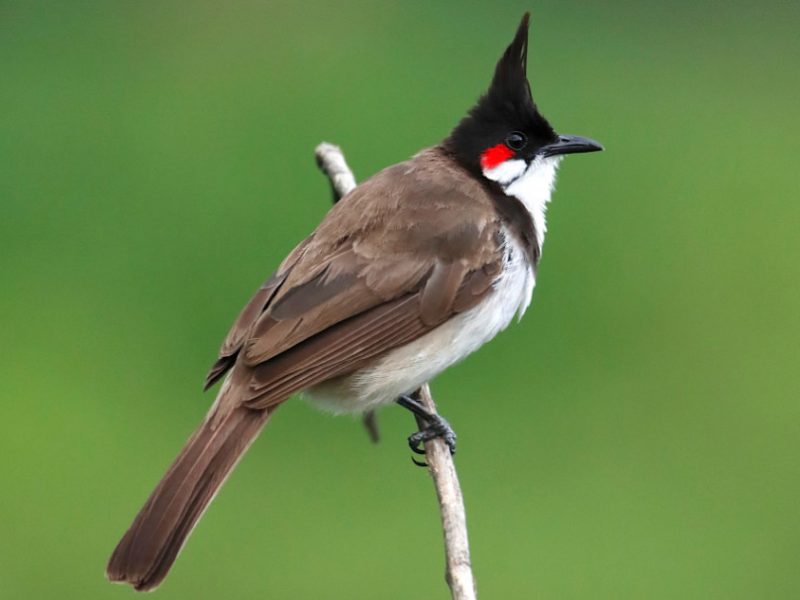
The black crest of the Red-Whiskered Bulbul (Pycnonotus jocosus) sets it apart from its nine subspecies, which can have either a long or short crest.
This bird has a unique coloring consisting of a black beak, a white face with red markings, and a black crown.
Its underbelly is white, and it has bright brown feathers on its wings and tail.
Red-Whiskered Bulbuls, native to Southeast and Southern Asia, are frequently found in gardens and are distinguished by their three-toned song.
Introduced and established in areas such as California and Hawaii, their distinctive appearance and musical calls lend beauty to a variety of settings.
Bohemian Waxwing
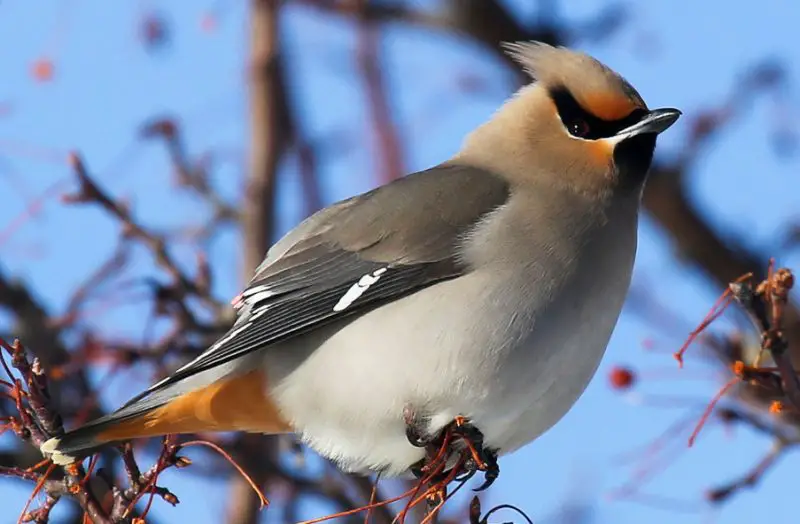
The gray plumage of the Bohemian Waxwing (Bombycilla garrulus) is distinguished by subtle red undertones and a gray crown.
Its wings and beak are characteristically black, and the borders of its wings are speckled with white, red, and yellow dots.
Notably, its ventral tail side, neck, and face are all colored rust-red.
While some may move to Southern regions, including North America, to overwinter in breeding climes, many do not.
Mostly feeding on fruits, they also adjust their diet to include seeds in order to survive the winter months.
The distinctive appearance and varied diet of Bohemian Waxwings, which are found throughout North America, Europe, and Russia, improve their habitats.
Red-Vented Bulbul
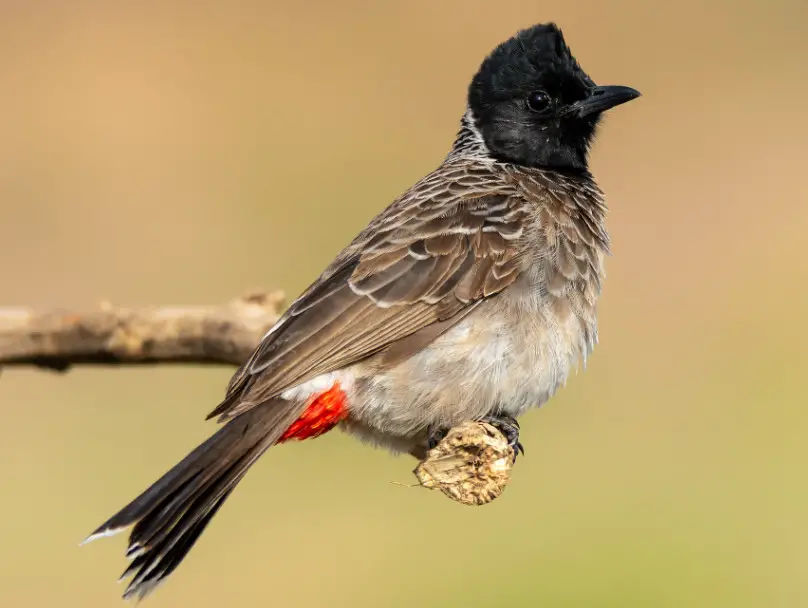
Male and female Red-Vented Bulbuls (Pycnonotus cafer) can be distinguished from one another by their black crest perched atop their black heads.
They have a characteristic white and red rump and a body that is primarily gray and white.
Males have a brilliant gray underside; females have hues of both bright and dark brown.
They are essential to their ecosystems because they consume fruits and insects as food.
These bulbuls, which are mostly found in Bangladesh and India, add to the region’s rich bird variety.
In their natural environments, they are a lovely sight and hear due to their stunning appearance and musical sounds.
Juniper Titmouse
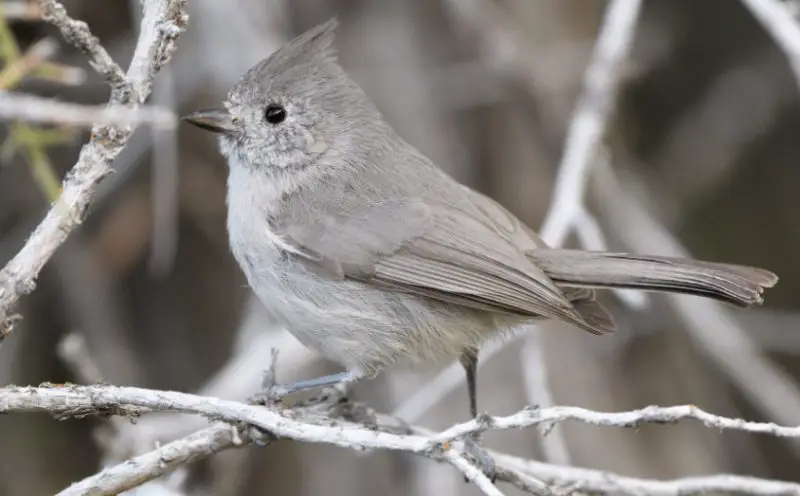
Named for its natural home in juniper woodlands in North America, the Juniper Titmouse (Baeolophus ridgwayi) has a drab appearance that sets it apart from other crested birds.
The bodies of both males and females are bright gray, including around the crest, with the wings having slightly darker gray tones.
Their beak and legs are dark gray to black in color.
They are mostly found in the Southwestern United States, which includes California, Arizona, and Mexico. They feed on insects, fruits, and seeds.
They are renowned for their agility, and one of their characteristic behaviors in their natural environments is hanging upside down while feeding.
Bridled Titmouse
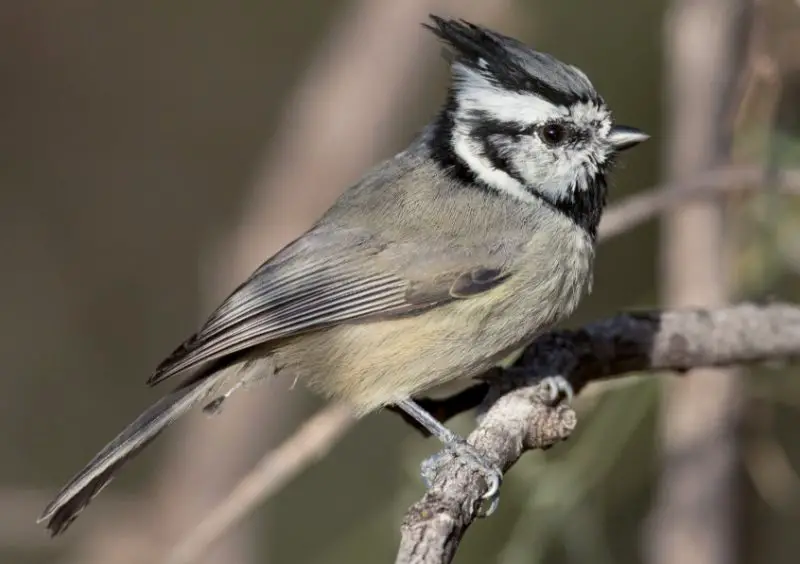
The characteristic multicolored crests and heads of Bridled Titmouse birds (Baeolophus wollweberi) are black and white in color.
Their faces are decorated with fine lines of crimson and black swirls.
Their plumage, which is both dark and bright gray, gives them a remarkable appearance.
They are found in a variety of habitats, such as hardwood or pine forests, riparian zones, and more. They adapt well to a wide range of conditions.
They frequently use tree holes and nests that they share with other species as breeding locations.
Bridled Titmice are native to areas like Arizona and Mexico, where their distinctive colors and adaptability enhance their surroundings.
Brown-Crested Flycatcher
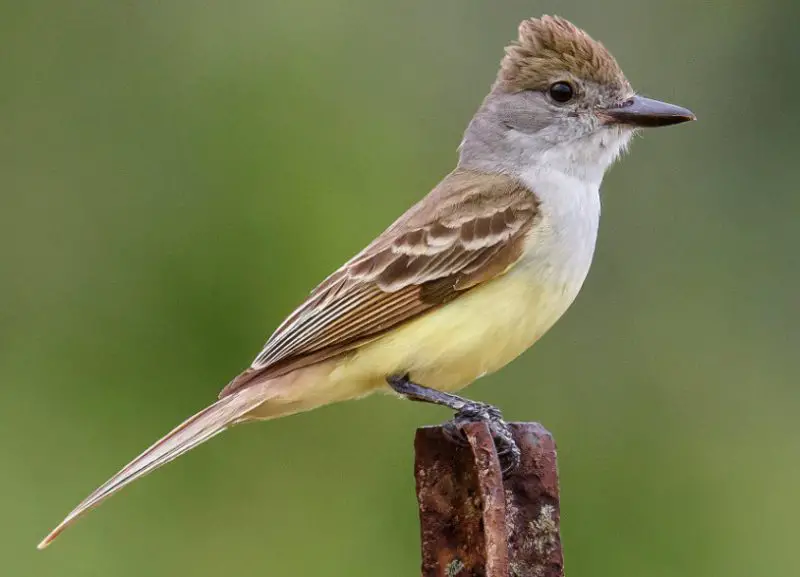
The enormous, fluffy brown crest, which varies in size and tint, is the distinguishing feature of the Brown-crested Flycatcher (Myiarchus tyrannulus), which is distributed across the Americas.
In addition to their dark brown wings, they have a varied plumage that ranges from a yellow to blue breast with a yellow underbelly.
They are primarily resident birds, while migratory numbers spend the winter in the southern United States. They are primarily insectivores.
They are usually found in open woodland settings, where they frequently use old tree holes for nesting.
The habitats of Brown-crested Flycatchers in Arizona, Texas, Florida, Central and South America, are enhanced by their unique crests and flexible nature.
Black-Throated Magpie-Jay
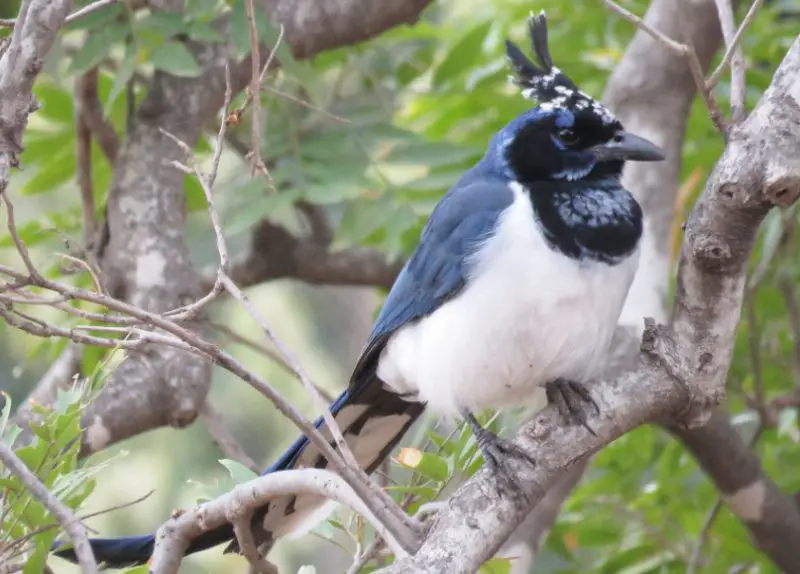
The long tail and crest of the Black-throated Magpie-Jay (Calocitta colliei) are distinctive features.
These birds have a black beak and black face, along with a black feather-like crest.
They have a remarkable dark blue color on their wings, backs, and tails that contrast with a brighter underside.
These birds prefer to reside in humid woodlands, where they frequently live alone or in pairs among the trees.
Despite their noticeable appearance, they could be difficult to find, given their size of up to 30 inches.
Although they are mainly found in Northwestern Mexico, they are now more common in the United States, especially in the Tijuana River Valley, which is close to San Diego.
They are easily recognized in their wooded environment thanks to their striking black crest.
Northern Lapwing
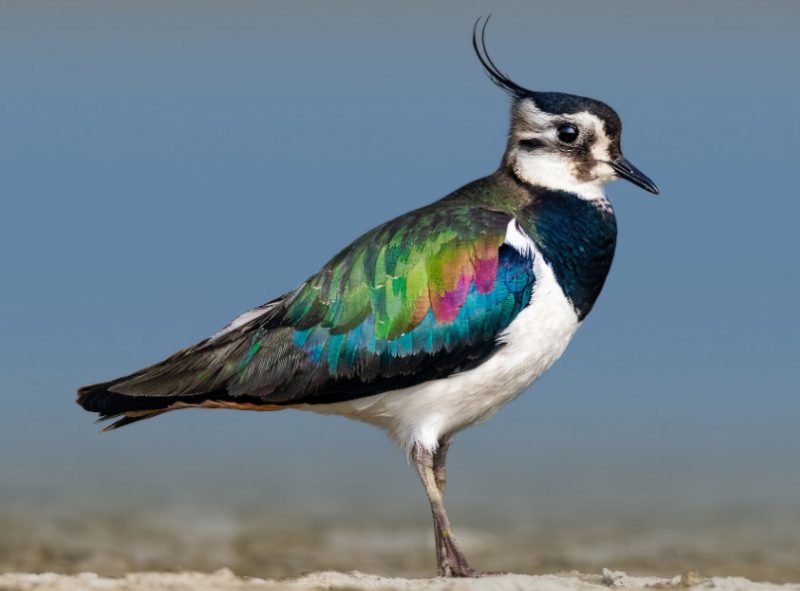
One can recognize the Northern Lapwing (Vanellus vanellus) by its black crown located behind its head.
Its shiny green wings contrast with its striking black and white head and body.
This species is often found in Asia and Europe, and it is also occasionally seen in the mudflats of the US East Coast.
They create enormous breeding flocks and fiercely protect their nests, preferring open environments like crops and prairies.
They are not regarded as pests even though they live in agricultural regions because they mostly feed at night on insects and other small rodents.
In their natural habitats, they are immediately recognized due to their remarkable look.
Red-Faced Cormorant
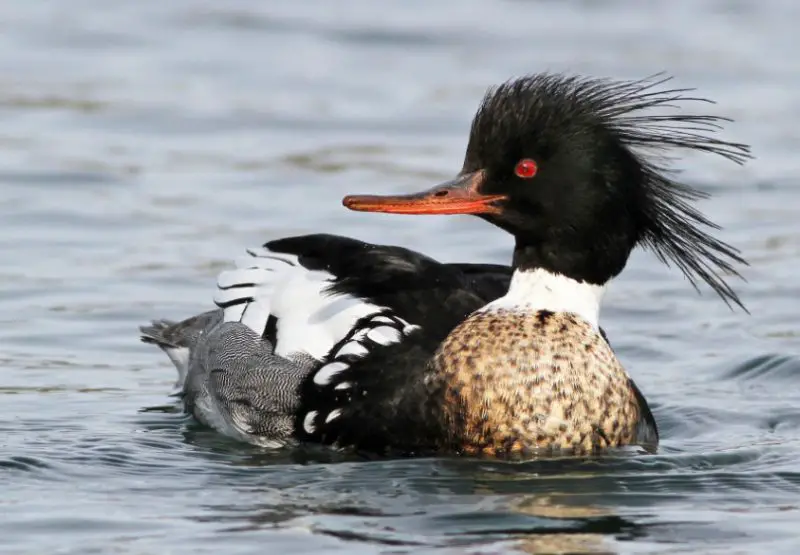
From a distance, the Red-faced Cormorant (Urile urile) seems practically black because to its distinctive dark green and blue plumage.
This cormorant, which gets its name from its eye-catching red face mask, has two black crests when it’s breeding.
One crest rests at the rear of the head, while the other is adorned around the eyes on the front.
These crests may be raised or lowered, and when the bird dives for fish, it usually lowers them.
They are expert divers who are good at capturing fish that live at the bottom of the ocean. They are mostly found in the Northern Pacific.
Crested Auklet

With around 5 million birds worldwide, half of which live in North America, crested auklets (Aethia cristatella) are a common sight in the North Pacific.
The tall black crest at the front of their heads serves as a distinguishing characteristic, and Crested Auklets utilize it in their mating rituals.
This unique crest is worn by both males and females and is important in the selection of mates.
Males with longer crests are frequently preferred by females, which causes them to switch partners for those who have more striking crests.
Krill is the main food source for these birds in their particular habitats along the North Pacific Coast, which is essential to both the birds’ diet and the environment.
Their preferred habitat stays away from heavily polluted sections of the water.
Oak Titmouse
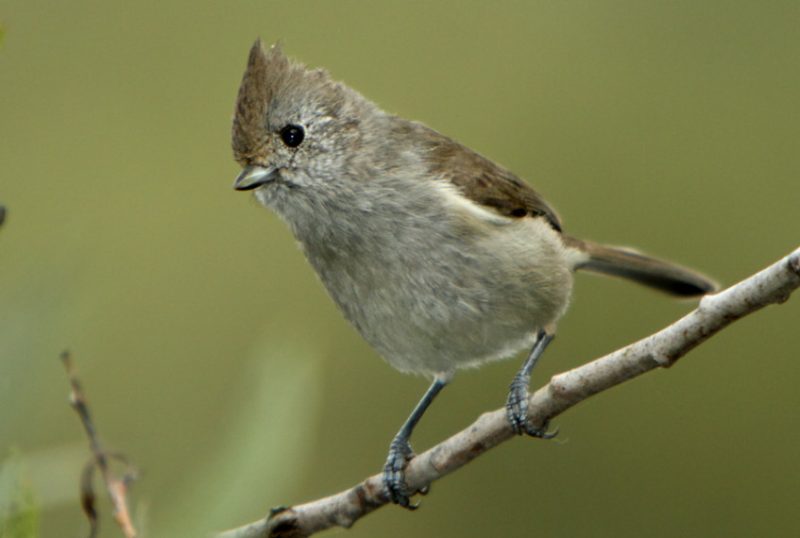
Both males and females of the Oak Titmouse (Baeolophus inornatus) have a small crest. Their looks are muted, but they are sexually dimorphic. The males have mostly gray feathers with a crest that matches, whereas the females have brown spots all over their bodies and a brilliant brown crest.
These birds live in woodlands and frequently share trees with other bird species. They are primarily found in the Southwestern region of the United States. They make new use of abandoned nests and tree cavities, lining their nests with grass.
Oak Titmice is primarily active from March to April. They can lay huge clutches of up to nine eggs, and the males will sometimes assist with the incubation process.
Ruffed Grouse
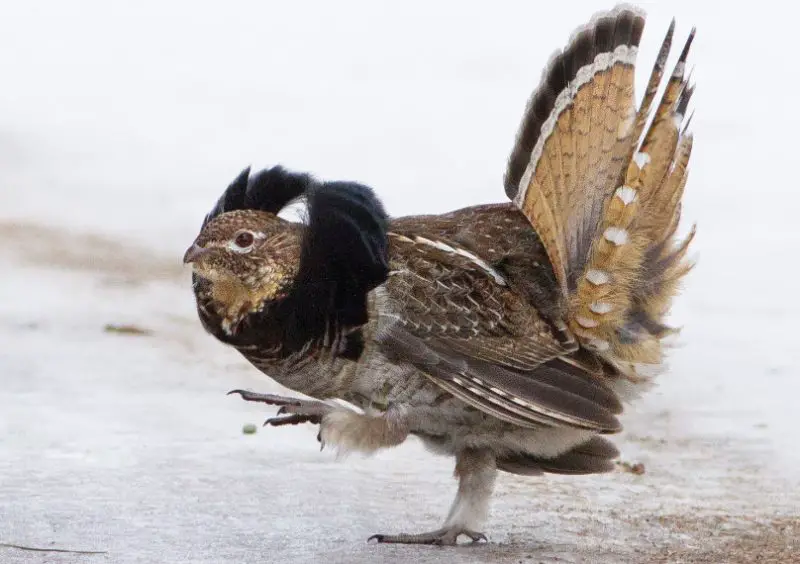
The elusive Ruffed Grouse (Bonasa umbellus) is a bird that can be found in the northern parts of the United States and Canada that have forests. Because both males and females have the same small crest, it is challenging to differentiate between the sexes solely by looking at their plumage.
These ground-dwelling birds show amazing adaptation; they burrow under thick layers of snow to survive hard winters. Often in isolated spots like leaf piles, females deposit clusters of up to 11 pale-colored eggs straight on the ground.
The Ruffed Grouse plays an important role in maintaining the equilibrium of forest ecosystems by using sandy areas as a means of eliminating insects.
Rufous-Crowned Sparrow
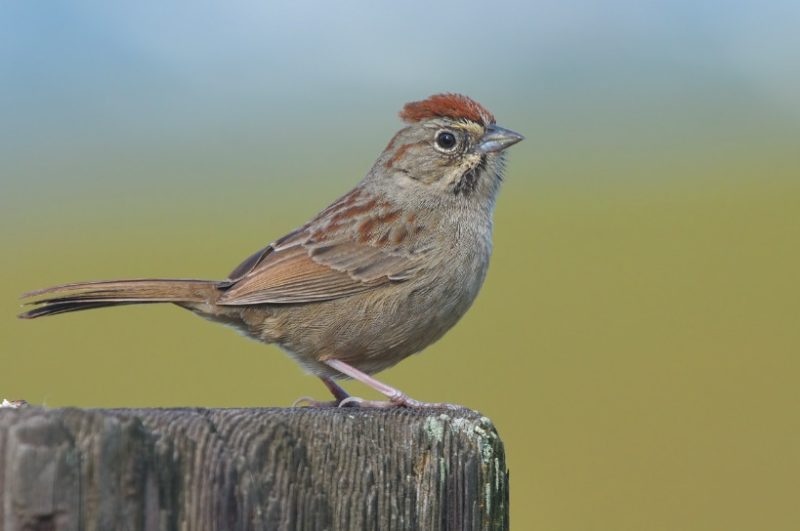
The short brown crest of the Rufous-crowned Sparrow (Aimophila ruficeps) is distinctive, and it is sometimes enhanced by brighter brown stripes close to the eyes. Its feathers display a range of gray and gray-brown tones.
This species is widespread across North America, especially in states like Arizona, Texas, California, and Mexico, and has more than 12 recognized subspecies. Because they are known to be gregarious, these sparrows often form mixed flocks with other bird species, sometimes numbering in the hundreds.
They do best in areas of open woods. The characteristic brown crest is an important visual clue for birdwatchers, allowing for quick identification in the field.
Scaled Quail
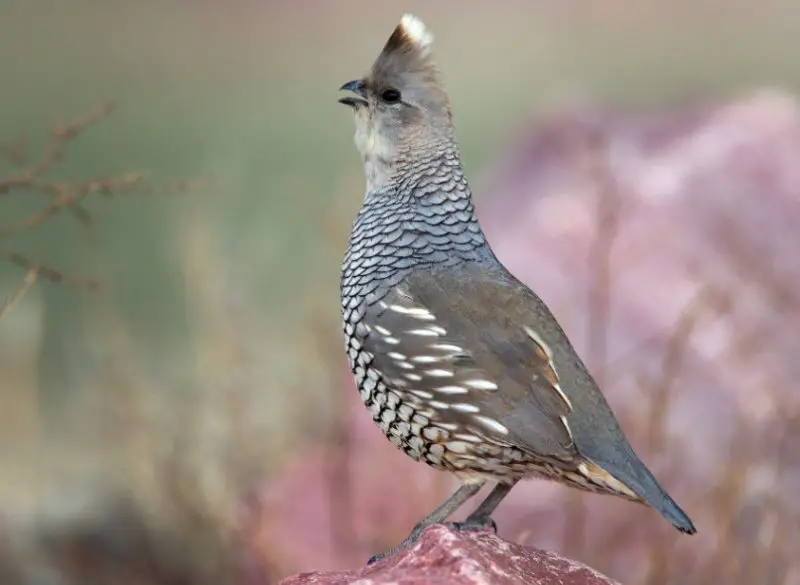
Known for being the only all-white characteristic on their body, the Scaled Quail (Callipepla squamata) is a prominent resident of desert grasslands. Their remarkable scale-like design is clearly seen on their bellies, where their bright gray plumage is displayed.
When it’s breeding season, female Scaled Quails are very visible since they are hard at work incubating their eggs. Interestingly, with up to 16 eggs deposited at a time, Scaled Quail nests are among the largest of any crested bird species.
Originating from Mexico, New Mexico, Texas, and Arizona, these birds show a predilection for sprinting over flying. For both researchers and bird enthusiasts, their distribution and white crest coloration with brown undertones serve as essential identifiers.
Dusky-Capped Flycatcher

Among crested birds, the Dusky-capped Flycatcher (Myiarchus tuberculifer) is unique in that it can live in a variety of habitats, including gardens and mixed and hardwood woods throughout several nations. Their feathers are dull brown and gray, and they have a little brown crest. Some of the birds have black heads and crests.
Interestingly, they have a bright yellow patch on their underside that gives them a colorful pop. Even though Dusky-capped Flycatchers are only slightly larger than 7 inches, they are skilled aerial predators that snag insects mid-flight.
They are a fascinating subject for birdwatchers worldwide, with their distribution spanning regions such as California, Arizona, New Mexico, Mexico, Nicaragua, Panama, Costa Rica, Venezuela, Colombia, and Ecuador.
Tufted Flycatcher

The distinctive olive crest of the Tufted Flycatcher (Mitrephanes phaeocercus) sets it apart from other birds. Their undersides are also a light shade of olive, which makes them stand out.
Young Tufted Flycatchers are more colorful and have a range of brown tones to them. Adults are more common in wet forests and have extra brown highlights on the sides of their heads.
Their underbelly varies in color from brown to olive to yellow-brown, depending on the elevation in the area, which can be as high as several thousand feet. Originating in Central America, Tufted Flycatchers visit places like the hot, dry Big Bend National Park in West Texas.
They are frequently found in areas of Mexico, West Texas, Costa Rica, Guatemala, Nicaragua, and Panama.
Greater Crested Tern
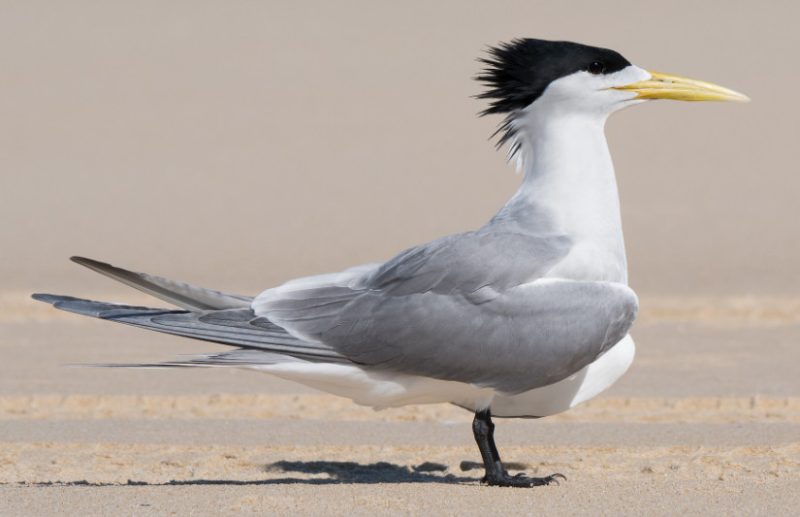
The Greater Crested Tern (Thalasseus bergii) is easily identifiable by its striking long black crest, contrasting sharply with its white head. This distinguishing feature is complemented by a black crown, adding to its distinctive appearance. The bird’s underbelly remains white, while its wings adopt a gray hue, creating a classic and elegant look.
Not generally migratory, this yellow-billed species spans from the East Coast of Africa to Australia, where it is notably numerous. Preferring ocean and lake pelagic fish, the Greater Crested Tern engages in fishing as its primary food source.
Uniquely, breeding within this species is a communal effort, with both males and females sharing the incubation duties in large colonies. This practice underscores the species’ cooperative nature, marking it as a standout among seabirds.
Their widespread distribution includes East Africa, The Middle East, Southeast Asia, Australia, and New Guinea, making them a prominent feature across diverse coastal landscapes.
California Quail
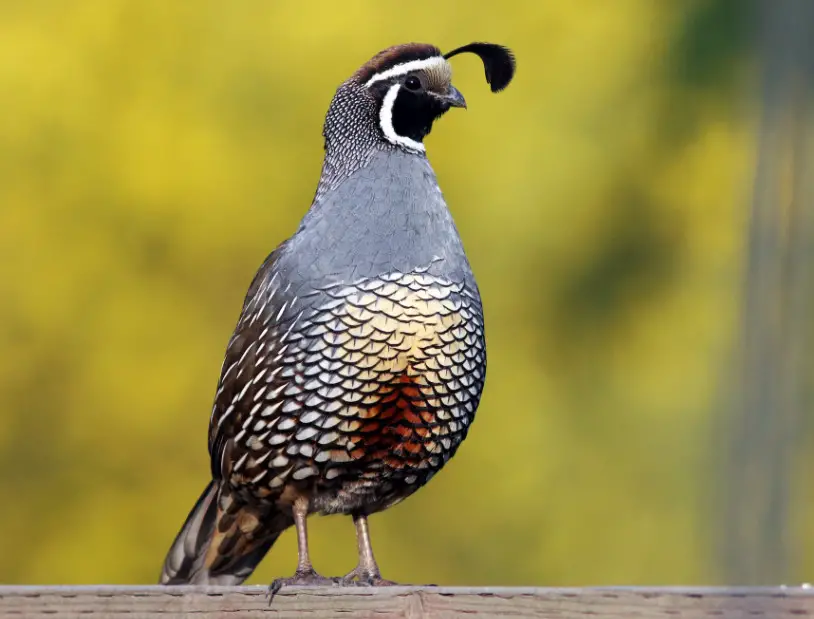
The distinctive characteristic that sets California Quails (Callipepla californica) apart is their long, comma-shaped crests, which slant forward on their heads. The size and color of their crests varies among these ground-dwelling birds.
In general, males have black crests, especially on darker individuals, while females have brown crests and lighter plumage.
The variance in crest length is influenced by geographic factors; quails in the Southern states, particularly California, frequently have longer crests.
They live in a variety of environments throughout their range, which includes the Western United States, Southwestern Canada, and Baja California.
All things considered, the California Quail’s distinctive crest and geographical variances make it a symbol of the West.
Red-Breasted Merganser
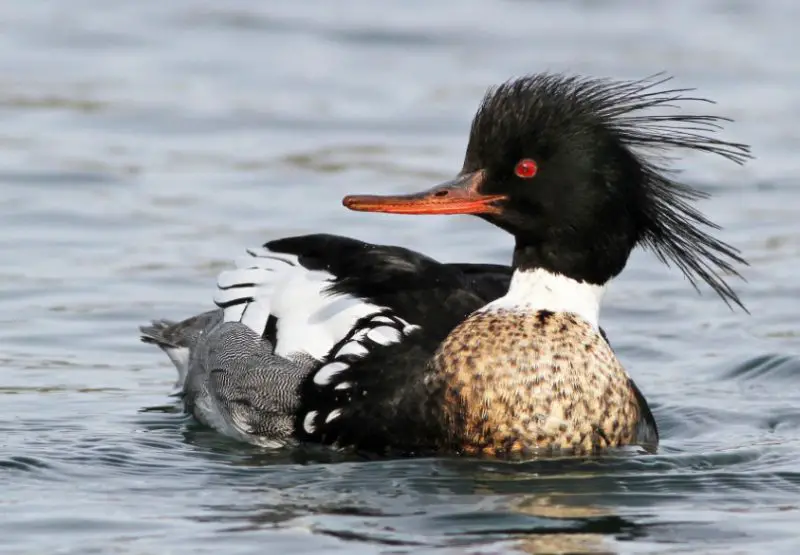
The remarkable crimson underbellies that crimson-Breasted Mergansers (Mergus serrator) display during the breeding season are the source of their name.
Male and female ducks have different crests; the former have black crests, while the latter have gray-brown crests that can be lowered or raised.
The spiky appearance of the crest acts as a breeding signal.
These skilled divers can be found hunting fish underwater in North America, Europe, and Asia, among other continents.
The Red-Breasted Merganser makes long migrations, first to overwintering grounds and then back to breeding grounds.
They are a beloved and identifiable species throughout their vast region of occurrence because of their colorful plumage and distinctive crests.
Greater Roadrunner
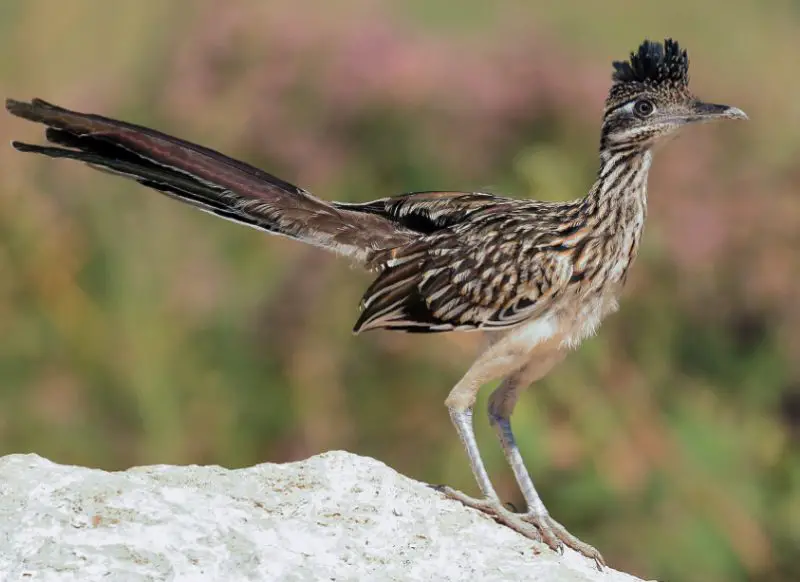
The Greater Roadrunner (Geococcyx californianus), which has a size range of 17 to 24 inches, is well known for its extraordinary speed. With the ability to run up to 20 miles per hour, they are excellent on land.
Like many other crested species, this streaking bird has a little black crest that it may raise or lower. The way the head is positioned affects how the crest looks, since roadrunners take on particular running stances.
The Greater Roadrunners’ heads and tails are positioned in a straight parallel line to maximize aerodynamics for quick running. They are primarily found in Mexico and the Southern United States, demonstrating their capacity to adapt to arid settings.
Royal Tern
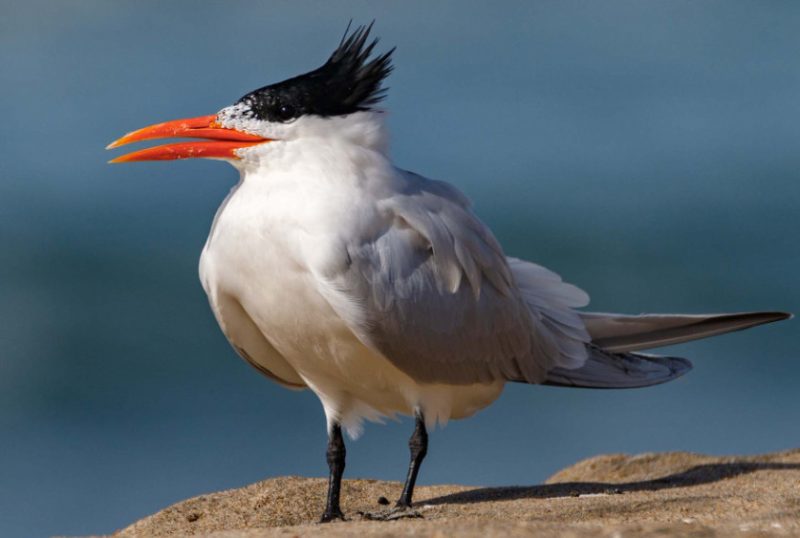
The remarkable black crest of Royal Terns (Thalasseus maximus) makes them clearly identifiable. The wings of these black-and-white terns are likewise brightly gray in color.
Coastal regions are home to Royal Terns, who are native to the Americas and spend much of their time at sea around Central America.
Although they can be spotted in small numbers on beaches, especially when they are nesting and breeding, they are rarely observed by themselves and frequently mingle with other seabird species.
Their range includes the Eastern Seaboard of North America, the Caribbean, Central American coasts, and the Northern South American coasts.
They stand out in the elegantly navigating coastal waters thanks to their characteristic black crest.
Phainopepla
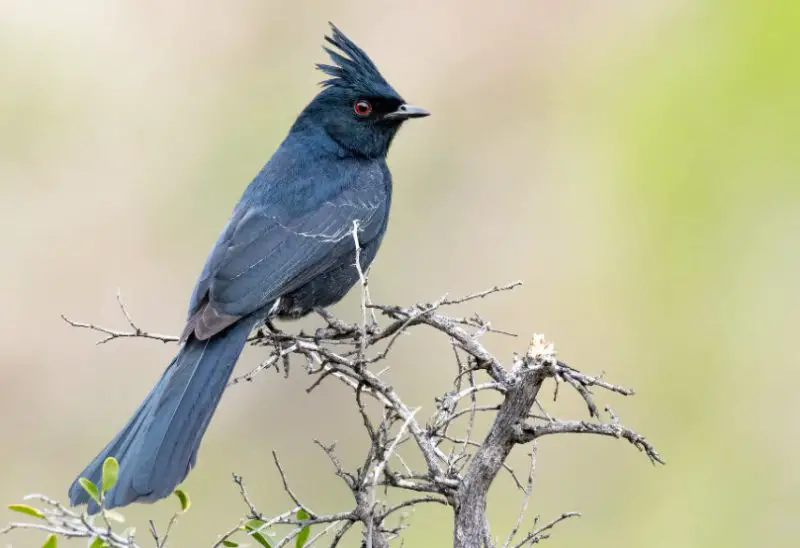
Male and female Phainopeplas (Phainopepla nitens) may raise or lower their moveable crests, which makes them unique.
Males of these birds are primarily black with black crests, while females are gray with corresponding gray crests. This indicates sexual dimorphism.
Phainopeplas are distinguished by their long tails, which can be gray or black in color.
The scientific name of the species is derived in part from the male’s glossy black plumage, which emphasizes its iridescent aspect.
With their unique colors and crest variations, Phainopeplas, which are found in California, Arizona, New Mexico, and Mexico, contribute to the bird variety of these regions.
Gambel’s Quail
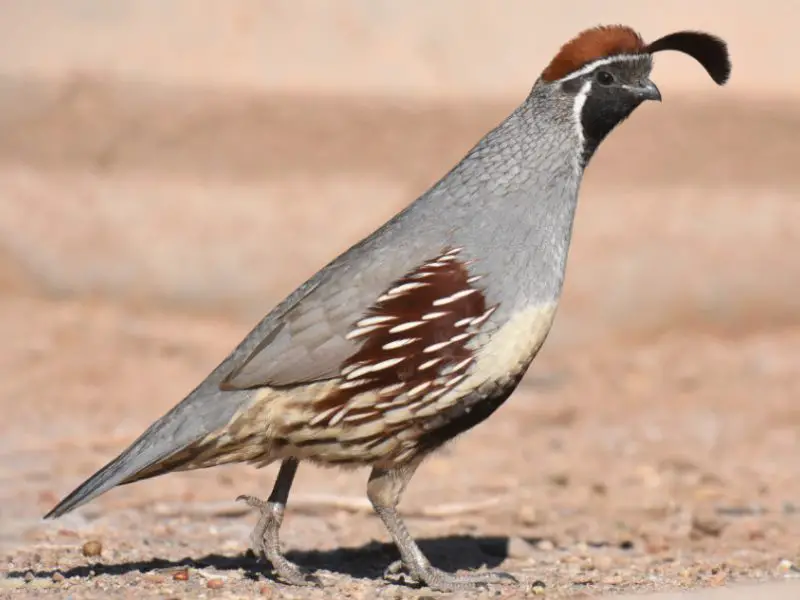
Male and female Gambel’s Quails (Callipepla gambelii) have different plumage. Both sexes have black, lengthy, forward-curving crests that resemble commas.
Males have a black face to go along with their black comma; their entire plumage is gray with brown wings.
Conversely, females have gray plumage as well, but instead of black faces, they have gray ones.
Gambel’s Quails are an endemic bird to California, Arizona, Nevada, New Mexico, and Mexico. Their characteristic black crests add to the allure of the parched environments in which they live.
Indian Peafowl
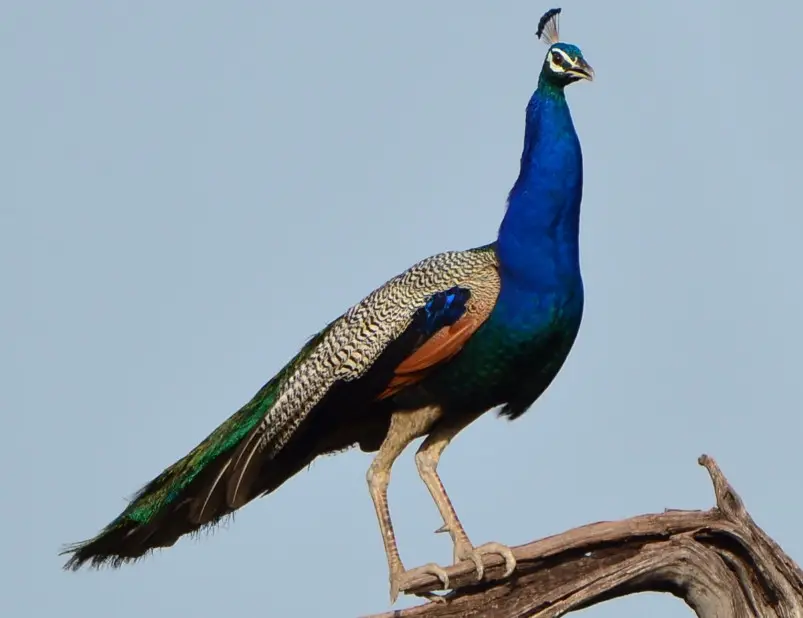
The exquisite beauty of Indian Peafowls (Pavo cristatus) is well known, as they show fan-shaped feathers when they court. These magnificent birds also have crests that resemble fans.
The pigmentation of the feathers varies between males and females, especially in the eyespots. Nonetheless, the fan-shaped crests of the two sexes are similar.
The color of the crest can vary; on white Indian Peafowls, it might appear black, blue and black, or even white.
These famous birds’ colorful plumage and crests probably contribute to their selective breeding, which makes them even more attractive.
Native to India, Indian Peafowls astonish onlookers throughout the world with their breathtaking beauty.



